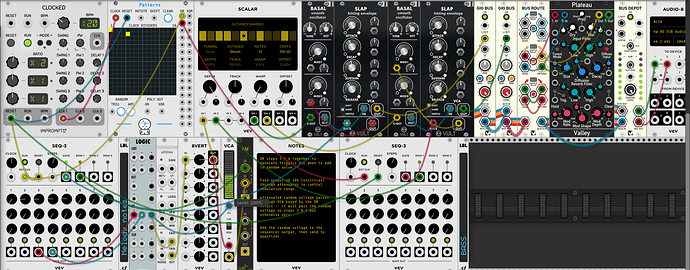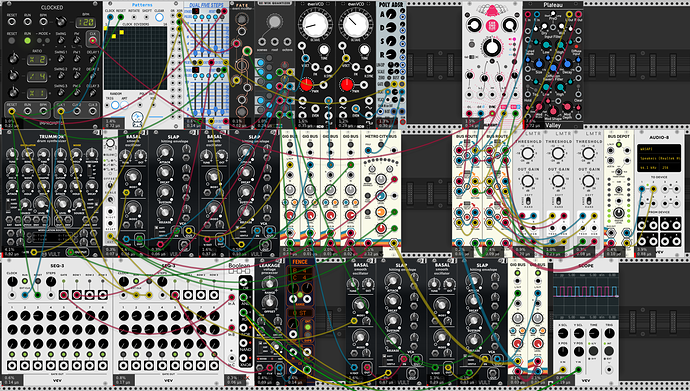This had to do with a question of how Caterina Barbieri programmed SOTRS. It isn’t optimal, but it demonstrates what I mentioned in my response: For a sequence where one note changes every time it repeats, it’s easier to consider it as two sequences, one for the lowest note and a second for the higher notes. And since SOTRS is based around a 5 note pattern, it seemed perfect to use the Buchla-esque NYSTHI “Dual 5 Steps” from @synthi. 5stepper.vcv (23.8 KB)
OK so Amine got back to me with a further thing he wants – to modify 2 steps out of the 5 and to use the SEQ-3 instead of the NYSTHI dual 5 step. This is interesting and my solution may not be optimal: Use a VCA to gate a random voltage to add to the sequencer’s row output.
What I notice is that there’s a little hiccup to the note pitch that I think comes from the VCA taking non-zero time to open up, since it’s meant to handle audio without clicks. Or it can be that the accumulation of 1-sample module delays means that the two values added together don’t arrive at exactly the same time. Or why not both??? ![]()
If someone else has a cleaner way to modulate just certain steps of a sequence, please reply! 5stepper2.vcv (31.6 KB)
Well, you can always use MicroMap from Stoermelder and map it to the steps you want to modulate. You can also use a sequential switch, like the one from ML, and use 7 instances of the same sequence, and another one of a random voltage so every now and then you will get a random note. If you want this on specific notes on the seq3, you can use the individual gate outputs to trigger the switch and set it in a way that it will send random voltages only on those specific steps.
Stoermelder often has solutions to edge cases like this one. I like Omri’s idea of using MicroMap. Another option is to use Stoermelder Strip, which has a randomization feature with the option to include or exclude any parameters you want. If you use Strip and include only the Seq-3 knobs you want to randomize, each time you click the Rand button (or sent a trig to the Rand input), you’ll get new random values on your chosen steps.
oh yes, that’s a nice one! (going to try it right now  )
)
How’s this ? Only the bottom row is Seq-3 but with the xor and and logic you can choose which step and, how many steps from 0-5 (if a 5 step sequence) the only thing I don’t like is that the inserted notes are random.
Barbieri 5 step - 21102019-V2.vcv (60.6 KB)



